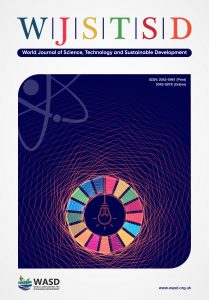Spatial–temporal dynamics of rainfall erosivity in the state of Espírito Santo (Brazil) from remote sensing data, Luana Moreira, Rafael Novais, Dimaghi Schwamback and Salomão Júnior
 Luana Lavagnoli Moreira
Luana Lavagnoli Moreira
Institute of Hydraulic Research
Federal University of Rio Grande do Sul, Porto Alegre
Brazil
Email: lavagnoliluana@gmail.com
Rafael Rezende Novais
Celulose Nipo Brasileira, Ipatinga
Brazil
Dimaghi Schwamback
Department of Hydraulics and Sanitation
University of São Paulo, São Paulo
Brazil
Salomão Martins de Carvalho Júnior
Federal Institute of Education Science and Technology of Espírito Santo, Vitoria
Brazil
DOI: 10.1108/WJSTSD-08-2019-0059
Purpose: The most common methodology to estimate erosivity is using rainfall data obtained from rain monitoring stations. However, the quality of this estimation may be compromised due to low density, operational problems and maintenance cost of rainfall monitoring stations, common problem encountered in developing countries such as Brazil. The objective of this study was to evaluate the applicability of pluviometric data obtained by TRMM satellite images for the spatiotemporal characterization of erosivity in the state of Espírito Santo (Brazil).
Design/methodology/approach: For this, rainfall data and annual and monthly erosivities of 71 rainfall stations were statistically compared with those from TRMM images.
Findings: For this, rainfall data and annual and monthly erosivities of 71 rainfall stations were statistically compared with those from TRMM images. The estimate proved that TRMM is efficient since the NSE values were higher than 0.70 and the coefficient of determination was higher than 0.77 for monthly and annual erosivities, but in most months and yearly, erosivity was overestimated.
Practical implications: The use of satellite images to estimate rainfall allowed the spatial representation over time (months) of the oscillating degree of erosivity in the state of Espírito Santo (Brazil). The spatialization may provide an identification of areas and periods in which are essential for the implementation of land use management in order to minimize environmental problems related to soil loss.
Originality/value: The technique applied may be an alternative to overcome common problems on rainfall monitoring station, such as low density, low data reliability, high manutention and maintenance cost and operational problems.
Keywords: TRMM satellite; Erosion; Precipitation; Geoprocessing techniques.
Citation: Moreira, L.L., Novais, R.R., Schwamback, D. and Carvalho Júnior, S.M.d. (2020), "Spatial–temporal dynamics of rainfall erosivity in the state of Espírito Santo (Brazil) from remote sensing data", World Journal of Science, Technology and Sustainable Development, Vol. 17 No. 3, pp. 297-309. https://doi.org/10.1108/WJSTSD-08-2019-0059

